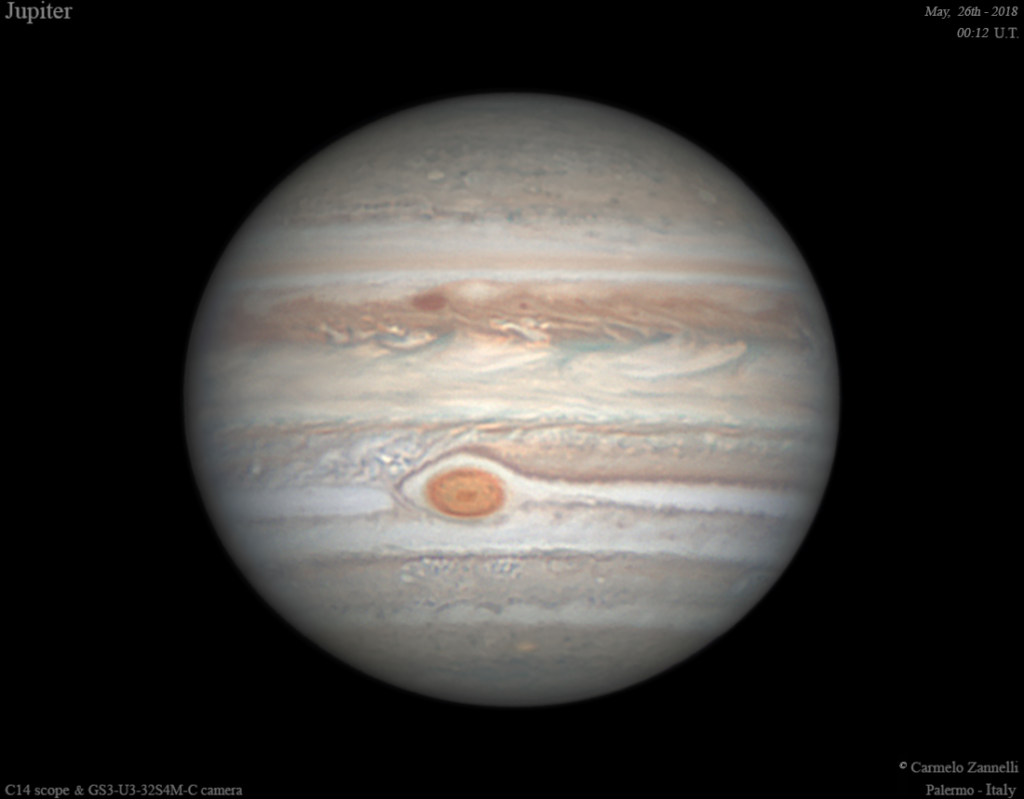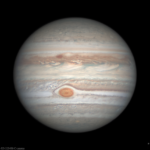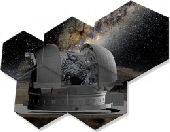******************************
******************************
Italian Language (for English, please read further below):
In una notte di tarda primavera, inaspettata a dire il vero, forse un pò poeticamente ispirata dal fatto che a giorni avrei malvolentieri venduto il mio caro telescopio Celestron C14 (a cui certamente penserò nostalgicamente) che in tanti anni mi ha dato visioni spettacolari del nostro cielo Siciliano, ecco che lui, il C14, decide di “regalarmi” una delle serate più belle mai avute, con cielo particolarmente stabile e calmo per le riprese planetarie in alta risoluzione. Il mio telescopio principale sarà, a breve, sostituito dal nuovo arrivato, sulla carta ben più potente: il mio nuovo telescopio Dall-Kirkahm 508mm ad F/12, di produzione “Astrofaktoria”, by Pawel Rojewski.
Riguardo questa bella ripresa di Giove, in condizioni di “seeing” eccellenti per le nostre latitudini (ho stimato un 8/10 sul Rosso, a posteriori, in fase di elaborazione), è in bella evidenza la Grande Macchia Rossa (GRS) che sta per passare al meridiano centrale, di un colore arancio molto carico, evidentissima in visione diretta all’oculare del telescopio, la quale come sapete è un vortice anticiclonico inserito in una scia molto turbolenta di correnti scavate nella componente sud della SEB (South Equatorial Belt); la Banda Equatoriale Nord (NEB) col suo “Barge” molto evidente, e tutta la serie di dettagli molto caotici visibili sia a latitudini polari sud che nord del pianeta.
Data la scarsissima altezza dei pianeti principali, alle latitudini italiane per questo e per i prossimi anni, è indispensabile, a mio parere, l’utilizzo del “Correttore di Dispersione Atmosferica” (chiamato ADC) che “raddrizza” lo spettro della luce, specialmente alle lunghezze d’onda più basse (dal verde in giù), quando l’oggetto osservato si trova ad altezze medie sull’orizzonte di osservazione, come al di sotto dei 40 gradi o meno (l’effetto è più evidente man mano che l’altezza diminuisce), a causa della rifrazione che la luce subisce quando passa attraverso gli strati dell’atmosfera terrestre.
L’immagine finale è il risultato della somma totale di circa 30.000 frames, rispettivamente 5 serie Red, 3 serie Green e 3 serie Blue !!
Ovviamente… ad maiora semper ! 😉
Dettagli tecnici:
Celestron C14 StarBright @ F / 33 – Baader-Zeiss Barlow lens – Baader RGB filter set – PointGrey GS3-U3-32S4M-C camera – Seeing 8 / 10 in
R band – website: Palermo city @ my personal Observatory
English Language:
In a late spring night, unexpected to me saying the truth, maybe a little poetically inspired by the fact that in few days I would have unwillingly sold my dear Celestron C14 telescope that in many years has given me spectacular visions of our Sicilian nightsky, here it, the “C14”, decides to give me one of the most beautiful night of ever, with a particularly stable and calm sky for high resolution planetary shots. My main telescope will soon be replaced by the newcomer: my new Dall-Kirkahm 508mm F / 12 telescope, produced by “Astrofaktoria”, by Pawel Rojewski.
Regarding to this Jupiter image, which means in terms of seeing “excellent” for our latitudes (I estimated an 8/10 on Red channel, in the post-processing fase), the Great Red Spot (GRS) is clearly in evidence in a very intense orange color, which is about to pass to the central meridian, very evident in direct vision to the telescope eyepiece; the GRS is inserted in a very turbulent wake of currents dug into the southern component of SEB (South Equatorial Belt) ; the North Equatorial Band (NEB) with its very evident “Barge”, and the whole series of very chaotic details visible both at the southern latitudes of the south and the north of the planet.
Given the very low height of the main planets, at the Italian latitudes for this year and for the nexts, it is essential, in my opinion, the use of the “Atmospheric Dispersion Corrector” (called ADC) that “straightens” the light spectrum, especially at the lowest wavelengths (from green to down), when the observed object is at average heights on the observation horizon, such as below 40 degrees or less (the effect is more evident as the height decreases), due to the refraction that light undergoes when it passes through the layers of the earth’s atmosphere.
The final image is the result of the total stack of about 30.000 frames, respectively 5 Red series, 3 Green series and 3 Blue series !!
Obviously … ad maiora semper! 😉
Technical details:
Celestron C14 StarBright @ F / 33 – Baader-Zeiss Barlow lens – Baader RGB filter set – PointGrey GS3-U3-32S4M-C camera – Seeing 8/10 in
R band – website: Palermo city @ my personal Observatory


